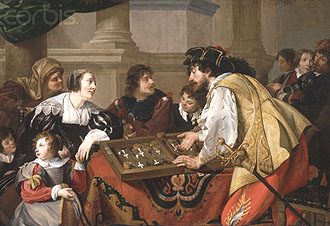|
| Magriel's NYT Columns |
 When you are considering a play, remember that the past history of the game is irrelevant. Each position must be viewed with fresh eyes, regardless of whether a spectacular turnabout has just occurred. Yet players, unlike dice, have memories. This why after a “miraculous” number has just been rolled, a player’s judgment often becomes distorted.
When you are considering a play, remember that the past history of the game is irrelevant. Each position must be viewed with fresh eyes, regardless of whether a spectacular turnabout has just occurred. Yet players, unlike dice, have memories. This why after a “miraculous” number has just been rolled, a player’s judgment often becomes distorted.
A recent game at New York’s Bar Point House of Backgammon illustrates this point. To understand what happened, it is necessary to backtrack one roll. On the previous turn, Black still had a man on the bar, and White, the overwhelming favorite, was about to begin bearing off.
|
| Black rolls 5-3. |
Next, White stayed out and the situation was reversed, with Black in the commanding position. Black redoubled, and White, refusing to accept defeat, impetuously took the cube at 4. White was at a severe disadvantage; in order for him to win, he would have to specifically reenter with a 1 and escape from behind Black’s prime with a 6.
Black was, of course, delighted at his good fortune. Not only had he turned the game around with a long shot, but his opponent had just accepted an ill-advised double. However, this unexpected turnabout distorted his usually sound judgment. Even though as things stood he was an overwhelming favorite, Black still had to play as accurately as possible in order to quash any chances his opponent might have for a comeback.
|
| Black to play 6-1. |
The correct play, however, is 13/7, 17/16, decisively slotting a man on the key point.
|
|
|
Black realized that slotting was the most direct way to carry out his plan, but he was intimidated into making an overcautious, ineffective play. “Haunted” by the 17-to-1 shot he had just rolled himself, he feared that White would now do the same.
The play that Black made was unduly conservative and so, in the long run, more dangerous. His play gave him only 6 possible combinations out of 36 to make the bar-point next roll, as opposed to the 19 combinations he could have given himself with the correct play.
Rollout
 Tom Keith 2013 |
|
Money play White owns 4-cube Black rolls 6-1 5184 games with VR Checker play: 2-ply Cube play: 3-ply Red |
| 6-1: | Game | G | BG | Equity | ||||
| 1 | 17/11, 13/12 |
W L |
.8589 .1411 |
.0428 .0373 |
.0010 .0006 | +0.6957 |

| (a) |
| 2 | 17/16, 13/7 |
W L |
.8637 .1363 |
.0481 .0582 |
.0012 .0015 | +0.6922 | (0.0035) | (b) |

|
|

